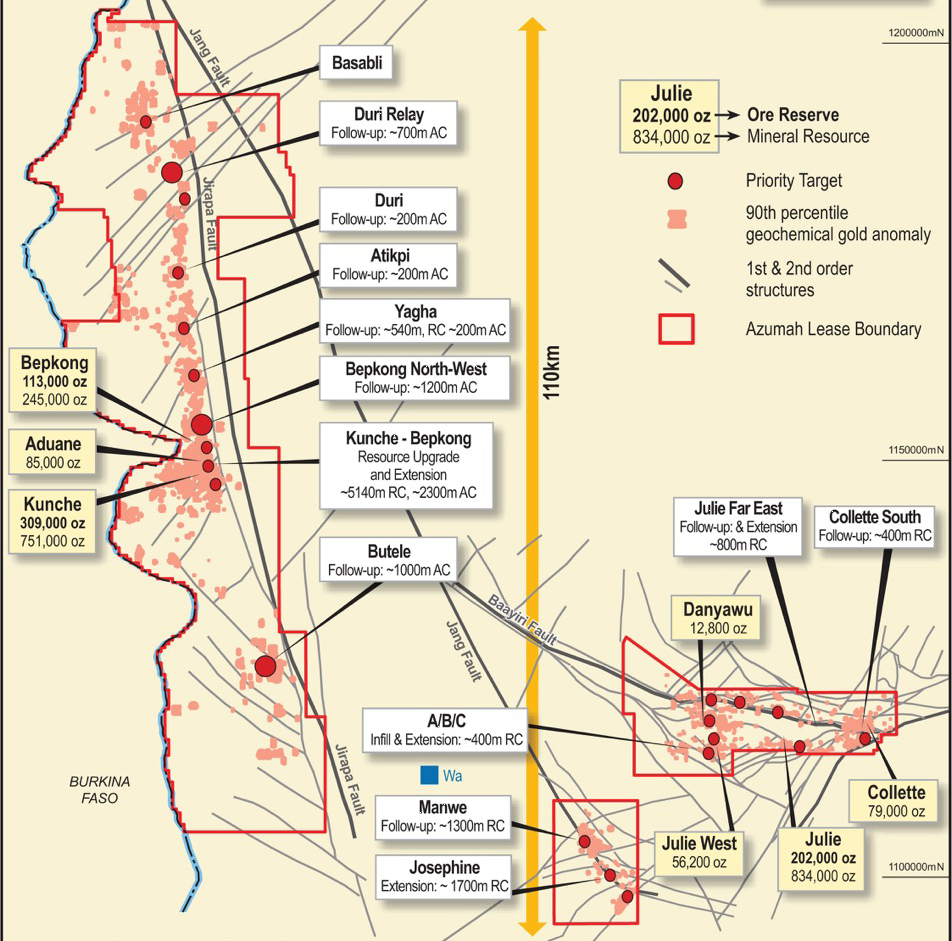West African focused gold explorer and developer, Azumah Resources Ltd, advises that exploration campaigns on multiple fronts have continued to progress the Wa gold project, Ghana towards its immediate goal of updating Mineral Resources in Q3 2018 and delivering an interim Ore Reserves update by end-2018.
Managing Director Stephen Stone said “The Wa project has delivered real game-changing results this June Quarter which has increased our confidence of increasing Mineral Resources and more importantly, Ore Reserves.
“We have continued our intensive, multi-target drilling campaigns as well as advancing the overall Wa Gold Project study update. Notably, several high-grade intercepts have opened up the possibility that mineralisation at Kunche could extend to considerable depth – consistent with similar style deposits around the world.
“Our exploration plans for the September Quarter include drilling to test the recently identified possible Kunche ‘feeder zone’, exploration drilling at the Danyawu, ABC, and Butele North targets and continued auger drilling at Butele North, Yagha Southwest and throughout our prospective 2,400 km2 tenure”. Priority targets are shown in the diagram.
- Additional Kunche RC hole provides further ‘proof of concept’ and depth confirmation for a possible feeder zone
- Kunche deposit modelling and Mineral Resource update underway and to be integrated into a Q3 2018 Mineral Resource update for the overall Wa gold project
- RC drilling intercepts at Kunche deposit south support possible deepening of current shallow pit
- Aircore drilling adjacent to current Kunche eastern pit wall confirms zones of shallow ore-grade mineralisation
Dr. Jon Hronsky, Global Targeting & Research Manager at Azumah’s joint venture partner, Ibaera said “We are extremely happy with the progress made on many fronts at Wa this past few months and in particular the ‘proof of concept’ drilling that may suggest a possible feeder zone into the Kunche deposit.
“Several drill rigs continue to test and evaluate a number of existing and new prospects across the whole project with the immediate goal being to update Mineral Resources in Q3 2018 and Ore Reserves before year-end.”
Three main deposits have been discovered and extensively drilled at Kunche and Bepkong, adjacent to the Black Volta River and Ghana’s border with Burkina Faso, and at Julie ~80 km to the east. Several satellite deposits, including Aduane and Collette, have also been delineated.
To date, the company has delineated a JORC 2012 Mineral Resource of 2.1 Moz of gold grading 1.5 g/t Au, including 1.4 Moz Measured and Indicated grading 1.7 g/t Au, with these evenly distributed between Kunche-Bepkong and Wa East (Julie deposit). Within this a JORC 2012 Ore Reserve of 624,000 oz Au (9.1 Mt at 2.14 g/t Au) has been defined.
Extensive metallurgical test work has confirmed a high average overall gold recovery of ~92% for the combined Kunche, Bepkong and Julie deposits.
Mineral Resources have been progressively grown through a focused, systematic approach to exploration of the company’s 2,400 km2 licence holdings, which encompass large tracts of prospective Birimian terrain, the rocks that host the majority of West Africa’s gold mines. Much of this is covered in soil, alluvium or laterite so most discoveries have been ‘blind’. Azumah anticipates Mineral Resources will grow substantially as it continues to test its large pipeline of target areas and specific prospects.
Azumah’s exploration strategy is primarily driven by its need to boost Mineral Resources to increase the existing Ore Reserve base from 624,000 oz towards 1.0 Moz. This would more solidly underpin a development decision and improve funding capability.
Azumah has two 15-year Mining Leases over its key deposits (Ghana government holds a 10% free carried interest in their ‘rights and obligations’ and is also entitled to a 5% gross gold royalty).
No technical, social or environmental impediments to development have been identified, no communities need to be relocated and rehoused and there is strong support from key stakeholders for the project, which benefits from excellent regional infrastructure including grid power to site, good quality bituminised and non-bituminised roads, easy access to water, a 2 km sealed airstrip at the regional centre of Wa and good general communications.











